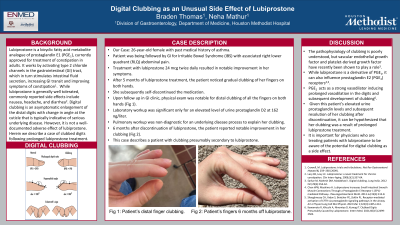Monday Poster Session
Category: Functional Bowel Disease
P1964 - Digital Clubbing as an Unusual Side Effect of Lubiprostone
Monday, October 23, 2023
10:30 AM - 4:15 PM PT
Location: Exhibit Hall

Has Audio

Braden Thomas, MD
Houston Methodist Hospital
Houston, TX
Presenting Author(s)
Braden Thomas, MD, Neha Mathur, MD
Houston Methodist Hospital, Houston, TX
Introduction: Lubiprostone is a bicyclic fatty acid metabolite analogue of prostaglandin E1 (PGE1), currently approved for treatment of constipation in adults. It works by activating type 2 chloride channels in the gastrointestinal (GI) tract, which in turn stimulates intestinal fluid secretion, increasing GI transit and improving symptoms of constipation (1). While lubiprostone is generally well tolerated, commonly reported side effects include nausea, headache, and diarrhea (2). Digital clubbing is an asymptomatic enlargement of the distal digits with change in angle at the cuticle that is typically indicative of serious underlying disease. However, it is not a well-documented adverse effect of lubiprostone. Herein we describe a case of clubbed digits following prolonged lubiprostone treatment.
Case Description/Methods: A 26-year-old female with past medical history of asthma was being followed for irritable bowel syndrome with associated right lower quadrant (RLQ) abdominal pain. Treatment with lubiprostone 24 mcg twice daily resulted in notable improvement in her symptoms. After 5 months of lubiprostone treatment, the patient noticed gradual clubbing of her fingers on both hands and subsequently self-discontinued the medication. Upon follow up, physical exam was notable for distal clubbing of all the fingers on both hands (Fig 1a). Laboratory workup was significant only for an elevated level of urine prostaglandin D2 at 162 ng/liter. Pulmonary workup was non-diagnostic for an underlying disease process to explain her clubbing. 6 months after discontinuation of lubiprostone, the patient reported noticeable improvement in her clubbing (Fig 1b).
Discussion: This case describes a patient with clubbing presumably secondary to lubiprostone. The pathophysiology of clubbing is poorly understood, but vascular endothelial growth factor and platelet-derived growth factor have recently been shown to play a role (3). While lubiprostone is a derivative of PGE1, it can also influence prostaglandin E2 (PGE2) receptors (4,5). PGE2 acts as a strong vasodilator inducing prolonged vasodilation in the digits and subsequent development of clubbing (6). Given this patient’s elevated urine prostaglandin levels and subsequent resolution of her clubbing after discontinuation, it can be hypothesized that her clubbing was a result of prolonged lubiprostone treatment. It is important for physicians who are treating patients with lubiprostone to be aware of the potential for digital clubbing.

Disclosures:
Braden Thomas, MD, Neha Mathur, MD. P1964 - Digital Clubbing as an Unusual Side Effect of Lubiprostone, ACG 2023 Annual Scientific Meeting Abstracts. Vancouver, BC, Canada: American College of Gastroenterology.
Houston Methodist Hospital, Houston, TX
Introduction: Lubiprostone is a bicyclic fatty acid metabolite analogue of prostaglandin E1 (PGE1), currently approved for treatment of constipation in adults. It works by activating type 2 chloride channels in the gastrointestinal (GI) tract, which in turn stimulates intestinal fluid secretion, increasing GI transit and improving symptoms of constipation (1). While lubiprostone is generally well tolerated, commonly reported side effects include nausea, headache, and diarrhea (2). Digital clubbing is an asymptomatic enlargement of the distal digits with change in angle at the cuticle that is typically indicative of serious underlying disease. However, it is not a well-documented adverse effect of lubiprostone. Herein we describe a case of clubbed digits following prolonged lubiprostone treatment.
Case Description/Methods: A 26-year-old female with past medical history of asthma was being followed for irritable bowel syndrome with associated right lower quadrant (RLQ) abdominal pain. Treatment with lubiprostone 24 mcg twice daily resulted in notable improvement in her symptoms. After 5 months of lubiprostone treatment, the patient noticed gradual clubbing of her fingers on both hands and subsequently self-discontinued the medication. Upon follow up, physical exam was notable for distal clubbing of all the fingers on both hands (Fig 1a). Laboratory workup was significant only for an elevated level of urine prostaglandin D2 at 162 ng/liter. Pulmonary workup was non-diagnostic for an underlying disease process to explain her clubbing. 6 months after discontinuation of lubiprostone, the patient reported noticeable improvement in her clubbing (Fig 1b).
Discussion: This case describes a patient with clubbing presumably secondary to lubiprostone. The pathophysiology of clubbing is poorly understood, but vascular endothelial growth factor and platelet-derived growth factor have recently been shown to play a role (3). While lubiprostone is a derivative of PGE1, it can also influence prostaglandin E2 (PGE2) receptors (4,5). PGE2 acts as a strong vasodilator inducing prolonged vasodilation in the digits and subsequent development of clubbing (6). Given this patient’s elevated urine prostaglandin levels and subsequent resolution of her clubbing after discontinuation, it can be hypothesized that her clubbing was a result of prolonged lubiprostone treatment. It is important for physicians who are treating patients with lubiprostone to be aware of the potential for digital clubbing.

Figure: Figure 1a: Patient's fingers when the clubbing was first identified.
Figure 1b: Patient's fingers 6 months after discontinuing lubiprostone.
Figure 1b: Patient's fingers 6 months after discontinuing lubiprostone.
Disclosures:
Braden Thomas indicated no relevant financial relationships.
Neha Mathur indicated no relevant financial relationships.
Braden Thomas, MD, Neha Mathur, MD. P1964 - Digital Clubbing as an Unusual Side Effect of Lubiprostone, ACG 2023 Annual Scientific Meeting Abstracts. Vancouver, BC, Canada: American College of Gastroenterology.
